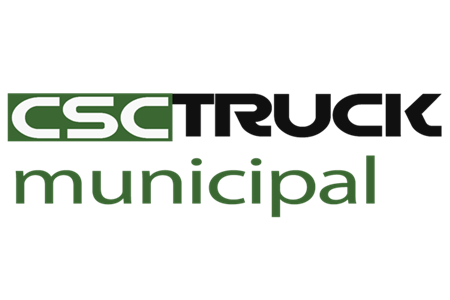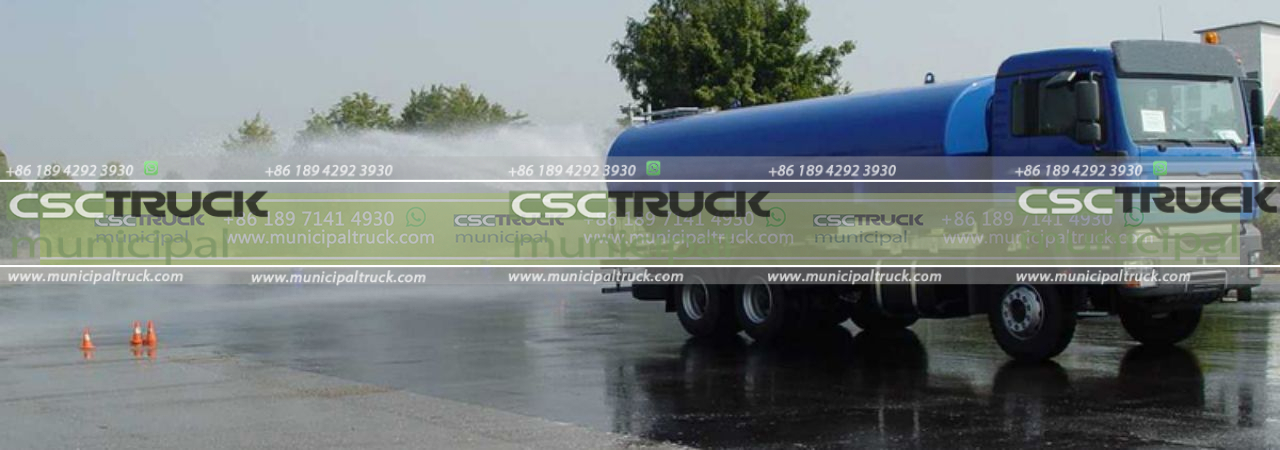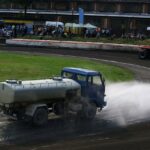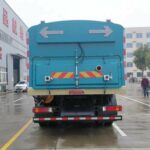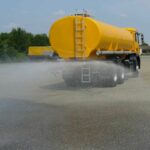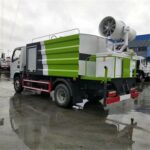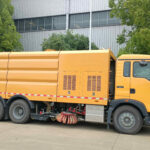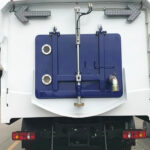As the specter of increasingly severe and frequent wildfires looms over communities worldwide, fueled by climate change, prolonged droughts, and accumulating vegetative fuels, the imperative for proactive, multifaceted prevention strategies has never been more urgent. While firefighting aircraft and ground crews command attention during active blazes, a critical line of defense operates far earlier in the timeline: the water spray truck. Far more than mere support vehicles, these specialized assets are evolving into sophisticated, mobile platforms for strategic fuel moisture management and pre-ignition mitigation, forming a vital, often underappreciated, component of a resilient wildfire prevention strategy. By delivering targeted hydration to high-risk zones before the fire starts, they actively manipulate the very conditions that allow wildfires to ignite and spread with devastating speed, transforming vulnerable landscapes into buffers of enhanced resistance.
Engineering Resilience: Anatomy of a Wildfire Prevention Water Spray Truck
The modern wildfire prevention water spray truck is a purpose-built machine, distinct from standard water tenders or municipal sprinkler trucks, designed for off-road capability, high-volume delivery, and precise application in challenging terrain. Its core components are engineered for resilience and effectiveness:
- High-Capacity, Ruggedized Tanks: Constructed from corrosion-resistant materials like polyethylene or coated steel, these tanks hold substantial volumes (often 2,000-4,000+ gallons) to maximize operational range between refills, crucial in remote areas. Baffle systems minimize water surge during movement over uneven ground.
- High-Pressure Pump Systems: Generating significantly greater pressure than typical utility trucks, these industrial-grade pumps (often 150+ PSI) are essential for creating the fine water mist or adjustable spray patterns needed for effective fuel moistening and dust suppression. Diesel-powered auxiliary engines frequently drive these pumps independently, ensuring consistent performance regardless of truck engine status.
- Advanced Spray Apparatus: The key to prevention lies in the spray system. This typically includes:
- Rear-Mounted High-Volume Spray Bars: For broad-area coverage of ground fuels along roadsides or treatment zones.
- Remotely Operated Roof-Mounted Turret (Monitor): Providing 360-degree articulation and long-range reach (often exceeding 100 feet), crucial for treating slopes, canyons, or areas unsafe for personnel on foot. Capable of switching between straight stream for targeted application and fog pattern for wide-area misting.
- Undervehicle Spray Systems: Optional systems designed for dust suppression directly beneath the truck, vital for preventing ignition from hot exhaust components during operations in extremely dry, dusty conditions.
- Off-Road Capability: Robust 4×4 or 6×6 chassis, enhanced ground clearance, aggressive off-road tires, and sometimes all-wheel steering are non-negotiable features, allowing access to the often rugged, undeveloped wildland-urban interface (WUI) and forest service roads where prevention work is most critical. Enhanced cooling systems prevent overheating during low-speed, high-power operations in hot environments.
Creating Defensible Space Through Strategic Moisture Deployment
The primary preventative function of these trucks is the deliberate manipulation of fuel moisture levels in strategic locations. This involves highly targeted operations:
- Pre-Wetting Critical Infrastructure Perimeters: Proactively applying water to create dampened buffer zones (typically 30-100 feet wide) around homes, communication towers, substations, historic structures, and entire communities within the WUI. This temporarily increases fuel moisture content in grasses, shrubs, and light litter, significantly raising the energy required for ignition and slowing initial fire spread if an ember lands, buying crucial time for evacuation and firefighting response.
- Roadside Fuel Treatment Corridors: Systematically treating vegetation along key evacuation routes and primary access roads. Maintaining higher fuel moisture along these corridors reduces the risk of fast-moving roadside fires blocking escape and firefighter ingress. It also combats dust clouds generated by traffic, which can pose visibility hazards and, in extreme conditions, present a secondary ignition risk.
- Mobilizing Against Spot Fires: During high-risk periods (Red Flag Warnings), trucks can be pre-positioned near known ignition sources (e.g., downed power lines, high-use recreation areas). Their rapid response capability allows them to quickly douse small spot fires or ember showers before they establish and spread, effectively acting as rapid-interception units.
- Supporting Prescribed Fire Operations: Water spray trucks are indispensable safety assets during controlled burns. They create wet lines to reinforce control lines, provide direct protection to personnel and equipment, and quickly extinguish any spots that jump the intended burn perimeter, ensuring the prescribed fire remains a preventative tool rather than an escaped incident.
Beyond Water Application: Dust Suppression and Fuel Reduction Synergy
The role of the water spray truck extends beyond direct vegetation moistening, contributing to prevention through environmental control:
- Critical Dust Suppression: On unpaved roads within high-risk zones, dust poses a multi-faceted threat. Thick dust clouds impair visibility on evacuation routes. More insidiously, fine combustible dust accumulating near ignition sources (vehicle hot exhausts, catalytic converters, discarded cigarettes, equipment sparks) can itself ignite, potentially starting a wildfire. Regular application of water or dust suppressants (like calcium chloride or organic polymers, often mixed in the tank) by spray trucks binds fine particles, mitigating both hazards. This is particularly vital near logging operations, construction sites, or heavily used recreational access points within wildland areas.
- Enhancing Fuel Reduction Efforts: Water spray trucks work synergistically with mechanical and manual fuel reduction programs. They can dampen areas prior to mastication (grinding brush and small trees) or chipping operations, drastically reducing the dust generated, improving operator visibility, and minimizing airborne particulate matter. Post-treatment, they can help settle residual dust and potentially apply soil stabilizers or seed slurries for erosion control on disturbed slopes.
Integrating Spray Tactics with Fire Behavior Science
Effective deployment is not arbitrary; it’s guided by a deep understanding of fire behavior and local risk factors. Prevention strategies leverage:
- Fuels Mapping & Risk Assessment: Utilizing detailed maps identifying fuel types (grass, chaparral, timber litter), fuel loads, fuel continuity, slope, aspect, and proximity to values at risk to prioritize areas for pre-wetting. Areas with heavy, continuous fine fuels on steep slopes facing prevailing winds demand the highest attention.
- Weather Intelligence: Operations are timed and calibrated based on hyper-local weather forecasts. Relative humidity (RH), temperature, wind speed/direction, and drought indices dictate the optimal timing (often early morning or late evening when RH is higher and winds lower, reducing evaporation loss) and frequency of applications. Fine mist applications are more effective when RH is higher.
- Moisture Monitoring: Understanding baseline live fuel moisture (LFMC) and dead fuel moisture content is crucial. Spray trucks aim to temporarily elevate dead fuel moisture above critical thresholds where ignition becomes easy. Knowing LFMC trends helps predict when vegetation becomes critically stressed and highly flammable.
- Strategic Placement & Logistics: Deploying trucks based on incident action plans for high-risk days, ensuring coverage of predetermined critical zones. Establishing efficient water shuttle operations or static water sources (foldable tanks, swimming pools, lakes with drafting points) near treatment areas is essential for sustained operations.
Environmental & Operational Considerations: Balancing Protection and Resources
The use of large volumes of water for prevention necessitates careful consideration:
- Water Sourcing & Sustainability: Prioritizing the use of non-potable water sources (recycled water, approved surface water drafting) where possible is crucial, especially in drought-stricken regions. Careful planning minimizes total water consumption by focusing on the most critical, high-leverage areas. Water conservation nozzles and calibrated application rates help optimize use.
- Runoff & Erosion Control: Applying excessive water on steep slopes or compacted soils can lead to mudslides or erosion, creating new hazards. Operators must be trained to apply appropriate rates and avoid oversaturation, particularly in sensitive watershed areas. Timing applications to allow for absorption before peak temperatures is key.
- Vehicle Impact: Operating heavy vehicles off-road inherently causes some soil disturbance. Sticking to established roads and minimizing travel in sensitive habitats is important. Undervehicle spray systems directly mitigate the truck’s own potential to ignite dry grasses via exhaust heat.
- Cost-Effectiveness: While an investment, the cost of deploying spray trucks for prevention must be weighed against the exponentially higher costs of wildfire suppression, property loss, environmental damage, and health impacts. Targeted, intelligence-led deployment maximizes cost-effectiveness by focusing resources where they provide the greatest reduction in potential fire spread and intensity.
The Future of Proactive Defense: Technology, Integration, and Ecosystem Management
The role of water spray trucks in wildfire prevention is poised for significant evolution, driven by technology and integrated approaches:
- Enhanced Sensor Integration: Incorporating real-time weather stations and soil/fuel moisture sensors directly on trucks or in target zones, feeding data to operators to optimize application rates and timing dynamically. Infrared cameras could detect subtle heat signatures indicating drying trends or potential hotspots.
- Precision Application Technology: Advancements in variable-rate spraying, guided by GPS mapping and sensor input, will allow for even more targeted application, conserving water and focusing only on areas below critical moisture thresholds. Drone-assisted reconnaissance could guide truck operators to specific drying hotspots within a designated zone.
- Advanced Fire Retardants & Gels: Wider adoption of long-term fire retardants and water-enhancing gels during pre-wetting operations. These additives can significantly extend the protective lifespan of a single application, adhering to fuels and resisting evaporation for days or weeks, creating more durable moisture barriers.
- Integrated Fleet Response: The water spray truck is one vital node in a network of specialized municipal and wildland fire assets. Its preventative moisture management works in concert with the road sweeper truck diligently clearing flammable dry leaves, pine needles, and debris from critical gutters, roadside ditches, and around infrastructure – eliminating the fine, rapidly igniting fuels that often carry fire. Simultaneously, the highly maneuverable water mist truck, capable of penetrating tighter urban interfaces within the WUI with its ultra-fine mist optimized for rapid heat absorption and minimal water damage, provides essential support in hardening structures and protecting vulnerable points during extreme risk periods. This synergistic fleet approach – combining strategic wetting, thorough fuel removal via sweeping, and precise misting capabilities – embodies a proactive, layered defense-in-depth strategy, fundamentally shifting the focus from reactive firefighting to the sustained creation of landscapes demonstrably more resistant to ignition and rapid wildfire spread.
